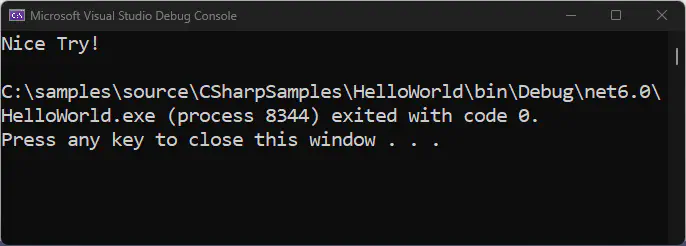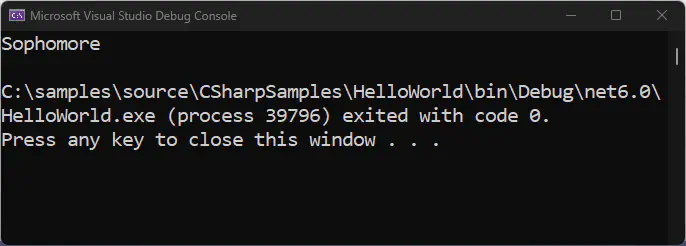Flow Controls (conditional statements) in C#
We will go through the different flow control structs in C#. These statements are used to make decisions and execute different paths of code based on a specific conditions.
if…else Statement
One of the most important construct in any language is condition checking.
In C#, we can do this in the form of if..else statement.
Below is the structure of the statement:
if (boolean expression)
Statement or block of statements
else
Statement of block of statements
Example of if..else statement:
class Program
{
static void Main(string[] args)
{
int grade = 12;
if (grade > 75)
{
Console.WriteLine("Congratulations!");
}
else
{
Console.WriteLine("Sorry! Please try again.");
}
}
}

if…elseif Statement
Example of if..elseif statement:
class Program
{
static void Main(string[] args)
{
int grade = 78;
if (grade > 85)
{
Console.WriteLine("Congratulations!");
}
else if (grade > 75)
{
Console.WriteLine("Nice Try!");
}
else
{
Console.WriteLine("Sorry! Please try again.");
}
}
}

nested if…else Statement
Since if...else is also a statement, you can use it inside if..else or what we called nested if statements:
class Program
{
static void Main(string[] args)
{
int grade = 90;
if (grade > 75)
{
if (grade > 85)
{
Console.WriteLine("Great!");
}
else
{
Console.WriteLine("Congratulations!");
}
}
else
{
Console.WriteLine("Sorry! Please try again.");
}
}
}

To avoid confusions when using nested statements, here are some guidelines:
Habit of using
{ }brackets with everyifandelseIndentation: aligning the code to enhance readability. Visual Studio will help with the auto indentation.
switch…case Statement
In performing a series of checks, switch..case can be used instead of an if..else.
The general structure of switch...case is below:
switch (integral or string expression)
{
case constant-expression:
statements
breaking or jump statement
// some other case blocks
...
default:
statements
breaking or jump statement
}
Here is a sample code on how to use switch..case in C#:
class Program
{
static void Main(string[] args)
{
int yearlevel = 2;
switch (yearlevel)
{
case 1:
Console.WriteLine("Freshman");
break;
case 2:
Console.WriteLine("Sophomore");
break;
case 3:
Console.WriteLine("Junior");
break;
case 4:
Console.WriteLine("Senior");
break;
default:
Console.WriteLine("invalid number");
break;
}
}
}

🔚 end of document 🔚